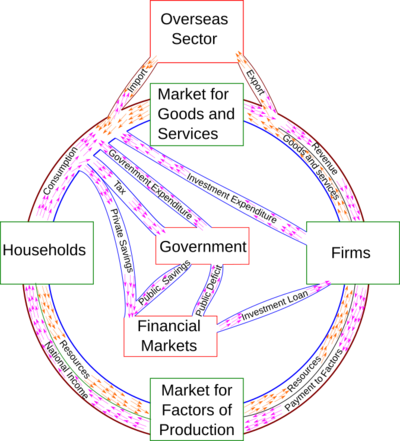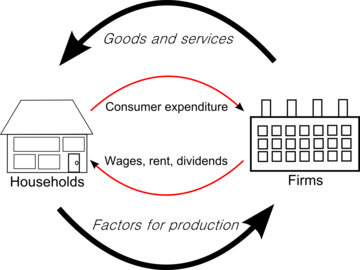
Back التدفق الدائري للدخل Arabic Flux circular de la renda Catalan Ekonomický okruh Czech Wirtschaftskreislauf German جریان مدور اقتصاد Persian Circuit économique French आय का चक्रीय प्रवाह Hindi Եկամտի շրջանաձև հոսք Armenian 収入循環 Japanese Economische kringloop Dutch


The circular flow of income or circular flow is a model of the economy in which the major exchanges are represented as flows of money, goods and services, etc. between economic agents. The flows of money and goods exchanged in a closed circuit correspond in value, but run in the opposite direction. The circular flow analysis is the basis of national accounts and hence of macroeconomics.
The idea of the circular flow was already present in the work of Richard Cantillon.[3] François Quesnay developed and visualized this concept in the so-called Tableau économique.[4] Important developments of Quesnay's tableau were Karl Marx's reproduction schemes in the second volume of Capital: Critique of Political Economy, and John Maynard Keynes' General Theory of Employment, Interest and Money. Richard Stone further developed the concept for the United Nations (UN) and the Organisation for Economic Co-operation and Development to the system, which is now used internationally.
- ^ Gwartney, James D.; Stroup, Richard L.; Sobel, Russell S.; Macpherson, David A. (2014). Macroeconomics: Private and Public Choice. Cengage Learning. pp. 173–175. ISBN 978-1-285-45354-5.
- ^ Daraban, Bogdan (2010-06-05). "Introducing the Circular Flow Diagram to Business Students". Journal of Education for Business. 85 (5): 274–279. doi:10.1080/08832320903449527. ISSN 0883-2323. S2CID 154585027.
- ^ Antoin E. Murphy. "John Law and Richard Cantillon on the circular flow of income." Journal of the History of Economic Thought. 1.1 (1993): 47–62.
- ^ Backhouse, Roger E., and Yann Giraud. "Circular flow diagrams." in: Famous Figures and Diagrams in Economics (2010): 221–230. Chapter 23.
© MMXXIII Rich X Search. We shall prevail. All rights reserved. Rich X Search